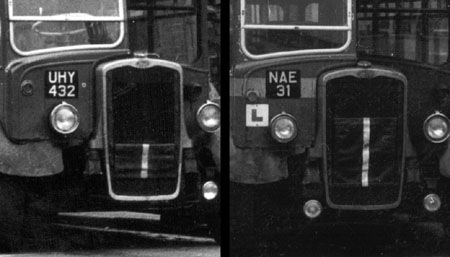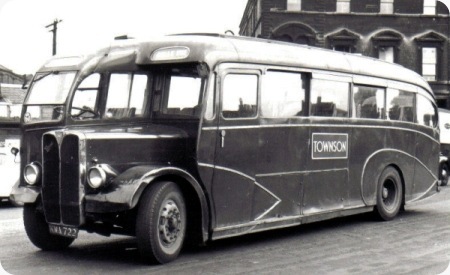
Sheffield United Tours
1949
AEC Regal III
Windover C32F
Looking in remarkably good shape for a contractor’s vehicle is this ex Sheffield United Tours AEC Regal III – chassis number 0962200, with a C32F body by Windover. It entered service in 1949, was sold on to Davies, Tredegar (via dealer) about July 1958, thence (via dealer) to Townson as shown, who operated it for about two years before selling on again.
What a great combination was the AEC Regal III/Windover half cab.
Photograph and Copy contributed by Les Dickinson
21/09/12 – 07:10
SUT had a goodly number of these vehicles on both the medium weight 068 as well as the heavyweight 0962 version of the Regal III. There were also a fair number of Duples – which were disposed of rather quickly/earlier than the Windovers. I’m too young (oh yes I am) to remember these half-cab Windovers in service. Apparently they were known for two things: (i) They were superbly finished – "even better than Duple" but (ii) the structure was suspect (with the common post-war use of "green" wood for the frames). These bodies were very popular with the BET companies who did substantial coach work (especially in the north). It was rare, however, for them to reach a ten year life-span with their first operator.
David Oldfield
21/09/12 – 08:32
I don’t recall seeing – and certainly don’t have any "bought" views of – these vehicles in reality, though I have seen them in model form. The models seem to capture the reality very well. I have vague memories of Townson vehicles in the late 1950’s and early 1960’s, when they, like Monk of Warrington and, of course, Wimpey, used old buses and coaches as staff transport.
Pete Davies
22/09/12 – 07:11
Some of the earlier SUT coaches were 0662 Regal I types and the name of the body was the Huntingdon. It was built in numbers on Leyland Tiger and AEC Regal chassis and North Western had quite a few Bristol Ls. I believe there were also one or two Guys. Windover then went on to have further success on Royal Tiger and Regal IV underfloor chassis with the Kingsway. [Personally, I thought this an ugly body – but then few could compete with the early Seagulls.]
Bizarrely, for a firm whose products (from the point of view of finish) were so highly regarded – and eminently suitable as touring coaches – they disappeared after the Royal Tiger/Regal IV era. I am not aware that they even got as far as bodying a Tiger Cub or Reliance. Doubly strange since they had been in business since 1766. Their factory was just down the road from Duple’s in north London.
David Oldfield
22/09/12 – 07:12
Davids point about BET companies in the North. As far as I know Ribble had some Windover’s, and although I’ve only seen pictures of them, Northern General had 8 on Guy Arab chassis fitted with Meadows engines, but they were later replaced with AEC A173 7.7 units. They were new in 1949 and by Northerns standards they had a relatively short life of only 8 years, they were gone by 1957.
Ronnie Hoye
22/09/12 – 07:13
I’ve always thought that this body from Windovers came a very close second to the Duple A type for it’s pleasing lines and symmetry. They got the look of this just right and it’s very easy on the eye compared to others of the time, some of which had the vertical framing pointing up in all directions, like badly arranged flowers in a vase! There’s no wonder that the BET group went for them in a big way although I had heard about the problems mentioned by David O, I understand that the roof and domes were notorious for leaking water into the saloon.
Chris Barker
22/09/12 – 07:13
Do any of the Sheffield contributors remember various SUT AEC Regal coaches operating on hire(?) to Sheffield Transport during the late 1950s? I particularly remember the fully fronted LWE registered batch operating on the 82 between Ecclesall and Middlewood with an honesty box just inside the entrance. I think this was more a result of a crew shortage rather than serviceable vehicles.
Ian Wild
23/09/12 – 06:45
Re S.U.T. coaches operating on hire to S.T.D. I can also remember travelling on them on the 82.
Also I remember that Batchelors hired a coach to "market" their products. They gave out free samples of their products! I recall that this was my first introduction to green pea soup.
Stephen Bloomfield
23/09/12 – 06:46
I’ve just been through the fleet history to make sure of my gut reaction, and Ribble never operated any vehicles with Windover bodywork. Some of North Western’s Huntingdon bodied Bristol L5Gs were "cascaded" to Melba Motors in 1958-61 and repainted in that subsidiary’s blue and cream livery. EFE have produced a 1/76 scale model of one of these Melba machines, depicted after sale to British Railways.
For customers wanting bodywork for underfloor engined chassis (but who considered the Kingsway too avant garde) Windover also offered the Queensway model with more "traditional" lines. Unfortunately it somehow resembled an electric-powered delivery van or milk float and its only major customer was Yorkshire Woollen District.
Incidentally, while it’s a well-known fact that the Kingsway body was named after the location of the BET Group’s head office (and the Queensway merely mimicked the nomenclature of the Kingsway), nobody has ever been able to tell me why the front-engined body was called the Huntingdon. Any suggestions?
Neville Mercer
23/09/12 – 06:50
Sorry pardon chaps, but not for the first time I’ve got it wrong, Northern General had 10 Windover Guy’s, I don’t know the full numbers of the batch, but one was BCN 26 fleet number 1226
Ronnie Hoye
23/09/12 – 06:51
Yorkshire Woollen had Windover coaches both half cab and a late batch of Royal Tigers. Incidentally when I got married the Rolls Royce wedding car had a Windover body c.1935.
Philip Carlton
23/09/12 – 06:52
I don’t recall hearing about SUT coaches on hire to Sheffield Transport Department before, but it certainly happened that Joint Committee buses went to work for SUT on occasion. Under the Sheffield heading of the ‘Vehicle Developments’ column, in Buses Illustrated issue no. 56 for November 1959, there’s a report that " …. Leyland Tiger PS1’s 1193-5, 1201/2 (KWE 93-5, KWE 1/2), which have Weymann bodes, were on loan to Sheffield United Tours in July."
Interestingly, in the same issue under the Sheffield United Tours heading, it mentions that the operator actually hired back AEC Regal III’s, 186/90 (LWE886/90) from the dealer to whom they’d already been sold, in order to assist with summer peak traffic. It must have been a busy summer at Charlotte Road!
Dave Careless
23/09/12 – 06:53
I did not know that Windover were in business as far back as 1766, but the firm certainly opened a factory in my nearby town of Huntingdon in 1796, building high quality carriages and, later, motor car bodywork for prestigious marques such as Rolls Royce and Bentley. The business moved to Colindale in north west London in 1924.The firm made aircraft components during WW2 and expanded into commercial vehicle bodywork postwar. In 1956 the company was taken over by Henleys and all coachbuilding activity ceased.
Roger Cox
23/09/12 – 19:37
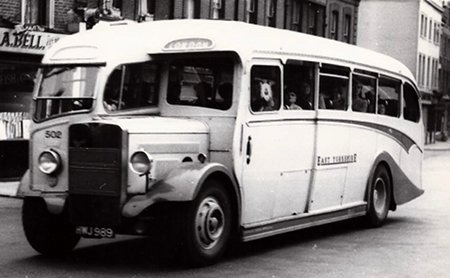
Photograph by ‘unknown’ if you took this photo please go to the copyright page.
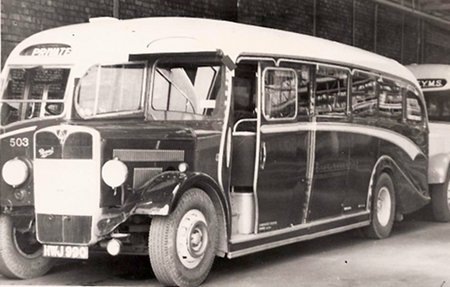
Photograph by ‘unknown’ if you took this photo please go to the copyright page.
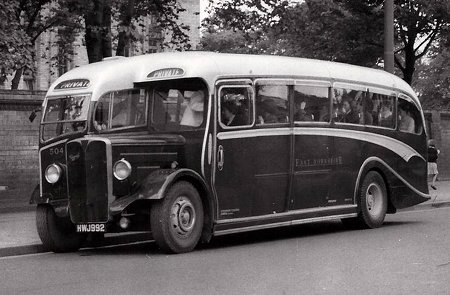
Copyright R F Mack
Just a follow up to the story on SUT Regals which may be of interest, EYMS purchased three of SUT 1947 Regal/Duple coaches in 6/48 becoming 502-504 HWJ 989/990/992 these lasted with EYMS until 9/60 and then all three passed to Lloyds of Nuneaton.
At first they were operated in SUT livery with EY fleet names before being repainted into EY’s indigo blue & primrose, I believe Yorkshire Traction also bought some from this batch as well.
Mike Davies
23/09/12 – 19:39
The Windover Kingsway did make it into the lightweight era, just. Two AEC Reliances appeared at the 1954 Commercial Motor Show with C41R bodies. They were MBE 611 for Hudson, Horncastle and RUP 843 for Gillett, Quarrington Hill. Biss Bros, Bishops Stortford also had four Kingsway bodied Foden PVRF6, NJH 847 of 1951, and NUR 197, NUR 198 and ORO 107 of 1952. A further BET customer for the Queensway was Red Line, W10, with OLX 1-3 on AEC Regal IV chassis. A picture of one appears in Ian Allan abc of Buses and Coaches, published around 1956, although wrongly described as a Reliance. At least the first and last were rebodied with Plaxton Panorama bodies, and photos of them in this form can be seen on Flickr.
David Williamson
24/09/12 – 07:18
The SUT AEC Regals were on hire to STD, I think in 1956, they also worked on the 110 Parson Cross via Owlerton service at peak times.
A colleague, the late Mike Gillott, became an auxiliary conductor, supervising the half cab forward entrance. He regularly travelled to and from his workplace on 82 Ecclesall duties, assisting the regular driver.
An acute staff shortage WAS the reason for the hiring.
Keith Beeden
24/09/12 – 10:31
Thank you for the information Keith, I recalled the honesty box and hence no normal conductor to take fares but I couldn’t remember how the manual door was operated.
Ian Wild
25/09/12 – 07:00
Roger answers the Huntingdon question.
Trent had some Regal IIIs – one I believe now owned by Steve Morris – and Timpsons had Regal IV/Kingsways (such as LUW 454 which worked on hire to SUT, complete with shield.) Thanks to Trevor Weckert for latter information.
David Oldfield
22/03/13 – 08:00
SUT was the winners of the 1st International coach rally in Montreux in 1949 with KWA 724, a Regal III with Huntingdon coachwork. they repeated this success the following year with LWE 892, one of the full fronted Regal III’s. Incidentally, the entire batch of full fronted Regal III’s were originally ordered as 7’6" (6821A)wide but when Ben Goodfellow, the new GM took over he modified the order to that of LWE 885-890 to remain as ordered but LWE 891-896 to the new 8′ wide specification (9621E). Regarding Batchelors Demonstrators..MWJ 197/NWB 198/9/203/4/6/8/OWA 210/111/OWB 215 were all used for this purpose.
Trev Weckert
20/11/18 – 11:11
Just found your website and photo (KWS 722) as I was looking for photo’s of Townson buses used as workmens transport. This bus was used daily on the Bolton to Manchester Piccadilly Station run when Townsons had the main contrct for the rebuilding of the station in 1964 /6. I worked for Townsons on that site and travelled on this bus daily during my employment there. I note that in the first comment the contributor says this was sold on after Townson’s use, but my recollection differs. In 1966 the transmission shaft became increasingly "clunky" and eventually it crashed up through the floor of the bus on a journey home to Bolton,in 1966, though I was not present at that time. I was told that the bus was eventually scrapped, by the person who regularly drove the buses for Wm. Townson. By the way, the door was operated by a large vertical lever on the inside which pulled inwards and backwards to operate the sliding mech. Hope this helps.
The photo is taken outside the old London Road station Manchester, before it was renamed Piccadilly Station.
Alec Fray


